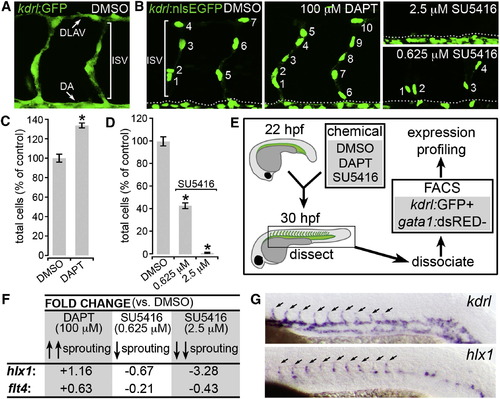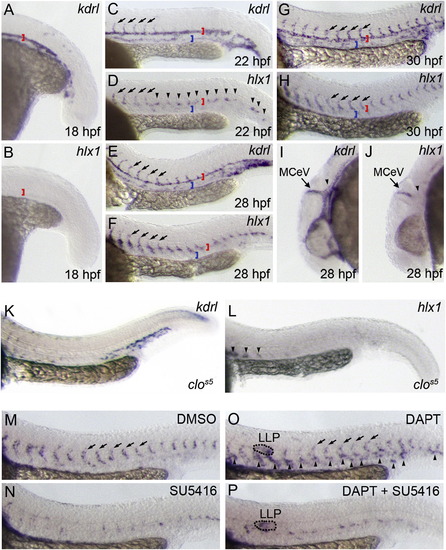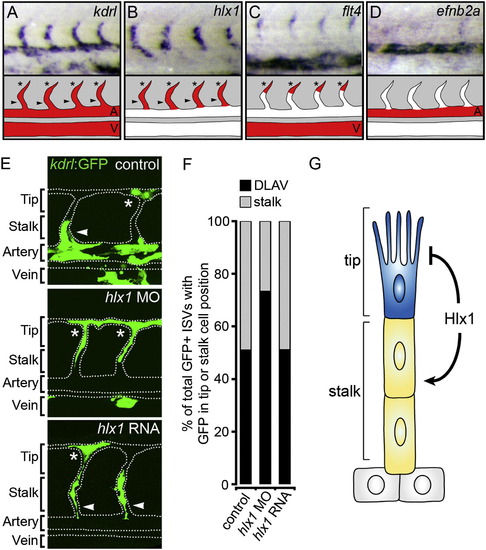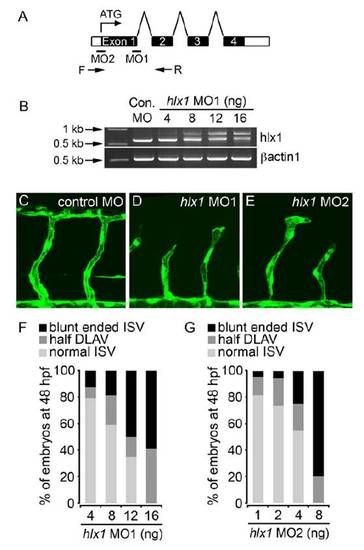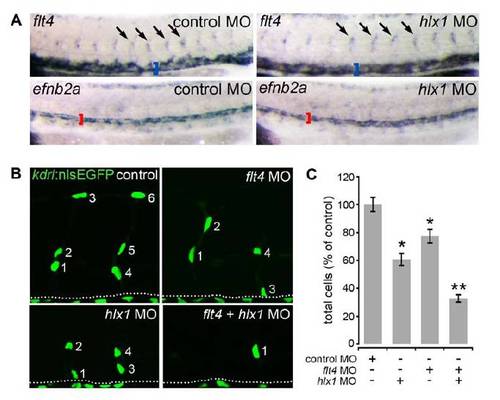- Title
-
Determination of Endothelial Stalk versus Tip Cell Potential during Angiogenesis by H2.0-like Homeobox-1
- Authors
- Herbert, S.P., Cheung, J.Y., and Stainier, D.Y.
- Source
- Full text @ Curr. Biol.
|
hlx1 Expression Is Associated with Angiogenic Cell Behavior In Vivo(A and B) Lateral views of Tg(kdrl:GFP)s843 (A) or Tg(kdrl:nlsEGFP)zf109 (B) embryos at 30 hpf following incubation with either 0.4% DMSO, 100 μM DAPT, 2.5 μM SU5416, or 0.625 μM SU5416 from 22 hpf. Arrows in (A) indicate positions of the DA (dotted line in B denotes DA) and the forming DLAV, whereas white brackets in (A) and (B) indicate sprouting ISVs.(C and D) Quantification of ISV EC numbers at 30 hpf upon incubation of Tg(kdrl:nlsEGFP)zf109 embryos with either 100 μM DAPT (C) or the indicated concentration of SU5416 (D) (n = at least 21 embryos). A total of 100 μM DAPT augmented EC sprouting during ISV angiogenesis, whereas 2.5 and 0.625 μM SU5416 dose dependently disrupted EC-sprouting behavior.(E) Strategy for the identification of genes associated with EC-sprouting behavior in vivo. EC sprouting was pharmacologically manipulated prior to FACS-mediated isolation and transcriptome profiling of kdrl:GFP-positive ECs from dissected zebrafish trunks containing sprouting ISVs. Contaminating kdrl:GFP- and gata1:dsRed-double-positive erythrocytes were removed during FACS.(F) Fold change in EC hlx1 expression upon incubation with the indicated chemical versus DMSO controls. EC hlx1 expression was tightly correlated with the level of EC-sprouting behavior in vivo.(G) Whole-mount in situ hybridization analysis of the pan-endothelial marker kdrl or hlx1 at 24 hpf. hlx1 expression was enriched in sprouting ISVs (arrows).Error bars represent mean ± SEM. p < 0.05 versus control, Student?s t test.See also Figure S1. |
|
hlx1 Expression Marks Sprouting ECsWhole-mount in situ hybridization analysis of kdrl (A, C, E, G, I, and K) or hlx1 (B, D, F, H, J, and L?P) expression at 18 (A and B), 22 (C and D), 28 (E, F, I, and J), or 30 (G, H, and K?P) hpf in untreated WT embryos (A-J), clos5 mutant embryos (K and L), or WT embryos incubated with DMSO (M), 0.625 μM SU5416 (N), 100 μM DAPT (O), or both 100 μM DAPT and 0.625 μM SU5416 (P) from 22 hpf (A-J; red brackets in A-H mark the DA, whereas blue brackets in C?H mark the cardinal vein). hlx1 is not expressed during early vasculogenic assembly of the DA (B) but is initially expressed in the first-sprouting ISVs (arrows in C and D) and at regions of future angiogenic remodeling (arrowheads in D). At later stages hlx1 expression is almost exclusively restricted to sprouting angiogenic ECs of the ISVs (arrows in E?H) and MCeVs (arrows in I and J) but is excluded from the adjacent nonangiogenic parental tissues of the DA (red brackets in A-H) and PHBC (arrowheads in I and J). (K and L) Both kdrl and hlx1 expressions are reduced or lost in EC-deficient clos5 mutants. Arrowheads in (L) indicate nonendothelial staining of the ventral somite. (M?P) SU5416-mediated suppression of EC sprouting abolished hlx1 expression (N), whereas DAPT promoted ectopic hlx1 expression in nonangiogenic tissues (arrowheads in O). DAPT-induced expression of hlx1 was lost upon coincubation of embryos with the VEGFR inhibitor, SU5416 (P) (LLP, putative lateral line primordium). EXPRESSION / LABELING:
|
|
Hlx1 Is Required for ISV Angiogenesis In Vivo(A?F) Lateral views of Tg(kdrl:GFP)s843 (A) or Tg(kdrl:nlsEGFP)zf109 (D; dotted line represents position of the DA) embryos and quantification of ISV morphology (B and C; ?half DLAV? refers to ISVs connected to only one adjacent ISV; n = at least 20 embryos) or ISV EC numbers (E and F; n = at least 15 embryos) at 30 (B and E) and 48 (C and F) hpf upon injection with either control MO (Con. MO) or hlx1 MO.(G) Quantification of the number of dividing ECs per ISV following live imaging of control or hlx1 MO-injected embryos from 19 hpf for approximately 13 hr (n = at least 30 ISVs from a total of 8 embryos).(H and I) Lateral views of control or hlx1 MO-injected Tg(kdrl:GFP)s843 embryos at 48 hpf (red arrows indicate DA; blue arrows denote cardinal vein). Hlx1 knockdown disrupts ISV sprouting (as indicated by asterisks in A and arrowheads in I), limits EC incorporation into ISVs (D?F), and reduces EC proliferation (G).(J) Lateral views of control or hlx1 morphants upon injection of FITC-dextran into the blood flow to assess vascular patterning at 48 hpf. White arrows indicate ISVs lacking blood perfusion. Red and blue arrows indicate arterial and venous blood flow, respectively. Arrowheads indicate ISVs that lack connections with adjacent ISVs. Blood flow through ISVs is disrupted upon Hlx1 knockdown.Error bars represent mean ± SEM. p < 0.05 versus control, Student′s t test. See also Figures S2 and S3 and Movies S1 and S2. EXPRESSION / LABELING:
PHENOTYPE:
|
|
Hlx1 Cell-Autonomously Maintains Endothelial SC Potential(A?D) Whole-mount in situ hybridization analysis of kdrl (A), hlx1 (B), flt4 (C), and efnb2a (D) at 30 hpf and diagrams displaying the expression domain of each gene (V, cardinal vein; A, DA; arrowhead indicates SC; asterisks denote TC). Whereas flt4 marks only TCs (C), hlx1 uniquely marks SCs (and possibly TCs) of the sprouting ISVs (B) and is excluded from nonangiogenic ECs of the DA, which express high levels of efnb2a (D).(E) Lateral images of control MO, hlx1 MO, or hlx1 RNA-injected donor Tg(kdrl:GFP)s843 cells in nontransgenic hosts at 30 hpf (dotted line represents position of the WT vasculature).(F) Quantification of the incorporation of donor cells into the DLAV position (asterisks in E) or stalk position (arrowheads in E) of individual host ISVs (n = at least 44 ISVs; control = 19 embryos; hlx1 MO, 17 embryos; hlx1 RNA, 26 embryos). When hlx1 is knocked down, ECs are lost from the ISV stalk position and accumulate in the DLAV position of sprouting ISVs.(G) Model summarizing the EC-autonomous function of Hlx1 during ISV angiogenesis.See also Figure S4, Movies S3 and S4, and Table S1. EXPRESSION / LABELING:
|

Pharmacological Manipulation of EC Sprouting and hlx1 Expression, Related to Figure 1 |
|
Knockdown of Hlx1 Using Gene-Targeted MO Reagents, Related to Figure 3 |
|
Flt4-Dependent TC Formation Appears Unaffected in the Absence of Hlx1, Related to Figures 3 and 4 |

